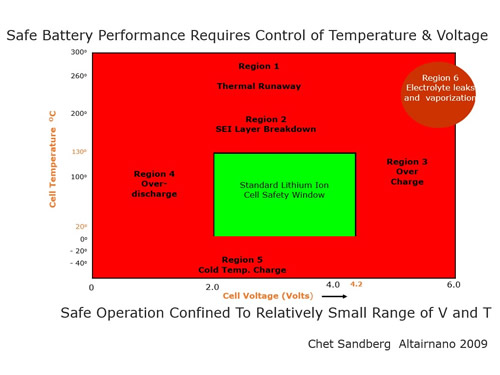articles
Aspects of Lithium Ion Batteries
By: Chet Sandberg
Tel: 650-493-2770
Email Mr. Sandberg
View Profile on Experts.com.
The 18650 cell has become the workhorse of the lithium ion battery industry and is a good candidate for analysis of most lithium ion batteries properties. Tesla automobiles, laptop computers, e-cigarettes, scooters, and grid energy storage all use the 18650. The 18650 cell is a leader in cost reduction, stored energy has been continually increasing and over 2 billion cells were manufactured in 2016. Lithium ion cells are truly a marvel of chemistry and electrical engineering.
However, when charged they can act like a small bomb and many fires have been reported when they are misused or malfunction. One of the most important issues with lithium ion batteries is the heat transfer from the cells. The 18650 is not only an energy storage system, it is an electrical resistor, and as such heats up when current flows through it. Thus, it heats up, both on charge and discharge and this heat must be removed to keep the cell temperature in the acceptable temperature range. Much of the engineering needed for 18650 applications is the control and removal of heat. The cell is a "chemical" system and suffers from operating at a high temperature. There are at least six failure modes for 18650's shown in the following chart.

The above chart needs a significant number of PhD theses to explain it. The chart failure modes contain chemical issues, heat transfer issues, mechanical issues and electrical issues. Under certain conditions, "dendrites" can grow from the anode and short to the cathode. This may cause a fire. The anode may become "clogged" with "solid electrical interface (SEI) particles, increase resistance, and increase temperature. Proper charging at the proper temperature is critical to safe operation. Add to that normal chemical aging and it is hard to determine the state of health of the cell. All this is very complicated and each failure mode or a combination of failure modes is possible depending on cell use history.
Manufacturing defects can also play a part with mechanical tolerances not held and internal short circuits possible. This has been documented by numerous recalls of lithium ion batteries products. Defects may not show up immediately but slight mechanical damage or vibration may initiate a failure. Add to this the possibility (actually probability) of "counterfeit" cells being available in the replacement market and you have a scenario that needs constant attention.
Even with the drawbacks mentioned above, the 18650 will provide reliable and safe energy storage when manufactured correctly and engineered properly into a final product. While battery management and monitoring systems (hardware and software) are critically necessary, they cannot completely eliminate all safety issues with 18650 cells or other lithium ion batteries.
Chet L. Sandberg is a Heat Transfer Expert with successful litigation in Steam and Electrical Heat Tracing. He has written papers on thermal insulation, LNG tank protection, heavy oil production, and appliance heat transfer. He has court room experience, including testifying before the ITC in Washington DC. Mr. Sandberg is available to attorneys for both plaintiff and defendant.
©Copyright - All Rights Reserved
DO NOT REPRODUCE WITHOUT WRITTEN PERMISSION BY AUTHOR.
Related articles
Follow us








